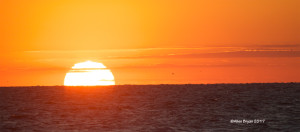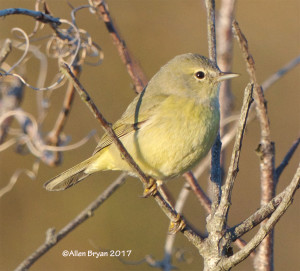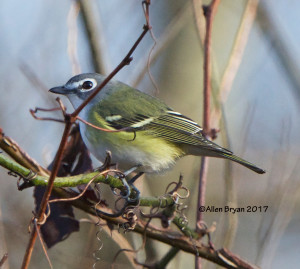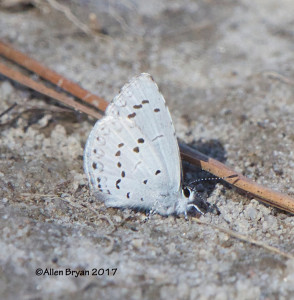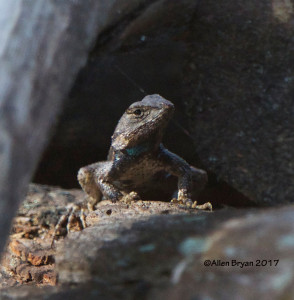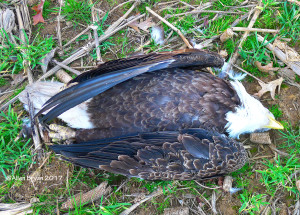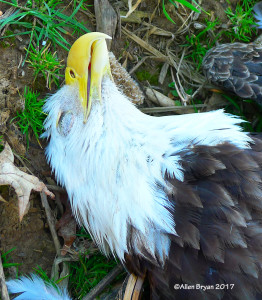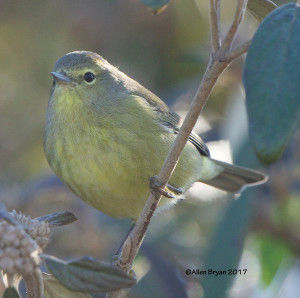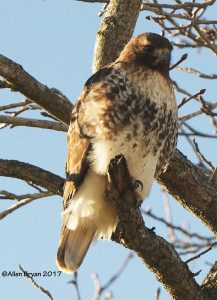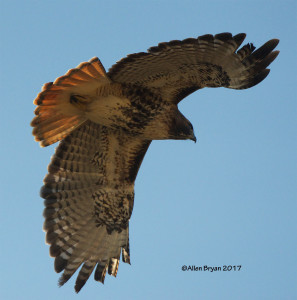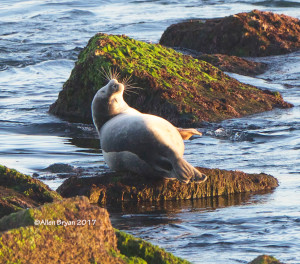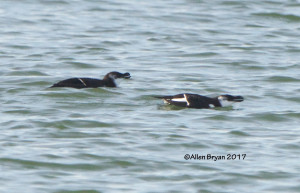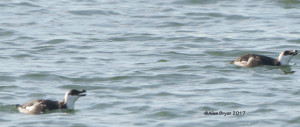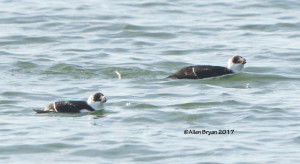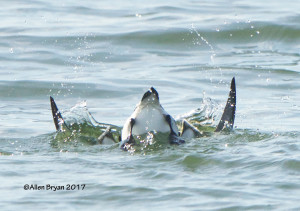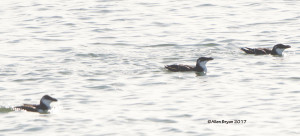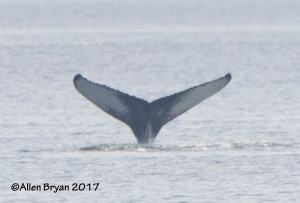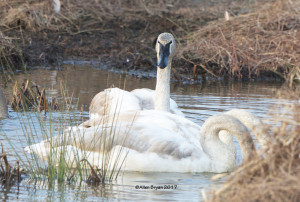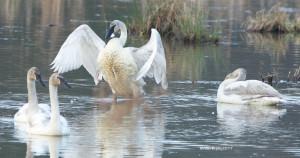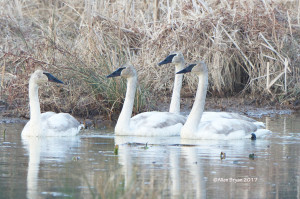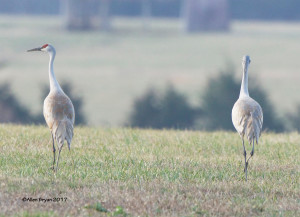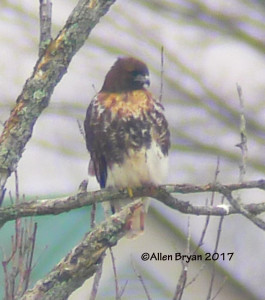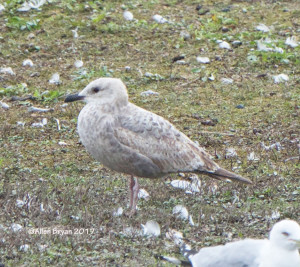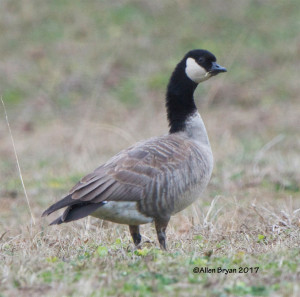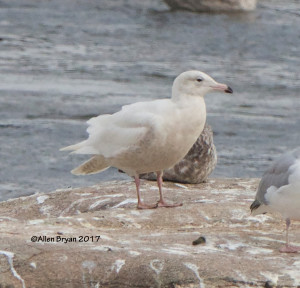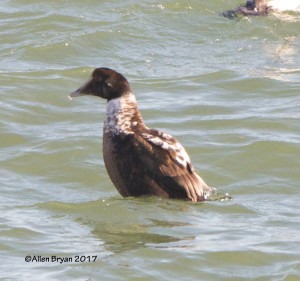February 26, 2017
Daybreak found me in the Back Bay NWR area. The front that had come through the evening before had substantially dropped the temperatures and winds were a constant 10 mph.
Red-throated Loons, Horned Grebes, Bonaparte’s Gulls and some N. Gannets were all moving north up the coast. No alcids were noted during the 45 minutes I “ocean watched”. As I departed the refuge a single Orange-crowned Warbler was noted feeding along the sound side thicket.
From this location I then traveled to Fort Monroe. Activity was much reduced from a week ago. Highlights at this location were a single Razorbill and four (4) American Oystercatchers.
February 25, 2017
I continue to question myself as to whether we are actually in February. Temperature at daybreak was 53 under partly cloudy skies in Sussex County, Virginia. Birds and frogs were in song and a few butterflies made their presence known by flitting about. Pine Warblers, Red-shouldered Hawks, Eastern Phoebes, Carolina Chickadees and Tufted Titmouse were some of the more vocal birds at many of the stops today. A possible wintering (?) Blue-headed Vireo was observed.
Pickeral Frog, Spring Peeper, Brimley’s Chorus Frog were the most vocal frogs heard during the day. An Eastern Fence Lizard was observed sunning itself on a log. Butterflies consisted of Eastern Comma and a probable Summer Azure. Many Bronzed Tiger Beetles were observed.
February 24, 2017
Tonight while walking adjacent to storm water basins in western Henrico County, Virginia I noted Spring Peepers, American Toads and Southern Leopard Frogs all calling with vigor from the very mild conditions we have experienced over the last several days.
February 19, 2017
I was in Prince George County about 30 minutes prior to sunrise this morning. The continued mild temperatures overnight, 42 degrees, have continued to stimulate “frog song” with Spring Peepers and a few Chorus Frogs making their presence known. Two (2) Great Horned Owls called prior to sunrise and as daylight quickly approached several Northern Harrier (7) got up from their nearby roost and starting dispersing for the day. Horned Larks were noted as paired up for the upcoming breeding season and Pine Warbler were actively singing from almost each stop. As I continued through the county I came upon a large concentration of Bald Eagle (11) which flushed from the area adjacent to the roadway and surrounding trees. Thinking that they were possibly feeding on a carcass I stopped and looked into the field. I was surprised to note a dead adult Bald Eagle. In review of the specimen I noted it had not been fed upon and demonstrated no obvious sign of death.
I briefly traversed a couple of areas in Charles City County and eastern Henrico County and found only a single Orange-crowned Warbler and a continuing Red-tailed Hawk (albieticola) of interest. Waterfowl numbers overall appeared diminished from both last week and the preceding weeks.
February 18, 2017
I left Richmond early and arrived at Island #1 of the CBBT at daybreak to calm seas, winds and warm conditions. Bird life was for the most part uneventful with some Gannets occasionally streaming into the bay, a few Bufflehead and scaup lingering about the island and three (3) Seals on the rocks as you face Island #2.
I did not cross the bridge tunnel but decided to travel over to Fort Monroe for some morning viewing. Activity in the bay off of Fort Monroe was much more stimulating. Double-crested Cormorants, Horned Grebes, Common Loons, Gulls, Brant and several Razorbills were present to provide some stimuli. I counted 7 Razorbills on the water up and down the water front at Fort Monroe. Several were singles but a group of 2 and 3 were also observed. Also present was at least one Humpback Whale(?) feeding up and down the waterfront.
February 12, 2017
I visited Louisa County this morning. Temperatures got no lower than 50 degrees overnight and skies were mostly cloudy early transitioning to partly cloudy and the winds were calm at daybreak with some noted minor increase prior to 10 a.m. when I departed. I had three to four (3-4) Short-eared Owls at their usual haunt along East Jack Jouett Road. Later in the morning after returning from Goldmine Road I observed the two (2) Sandhill Cranes that have been making their presence known for the last two winters. As I mentioned, I traveled to Goldmine Road and the marsh that has been hosting four (4) Trumpeter Swans first observed by Carson Lambert. Sure enough when I arrived they were toward the back of the marsh but during my stay they more closely approached allowing for some photographs. Also of note during the day was a beautiful Red-tailed Hawk (albieticola) which I observed along Highway 15. Another, not quite as handsome albieticola, was observed at great distance off of East Green Springs Road. Some photographs can be seen as follows:
February 11, 2017
I enjoyed a morning of birding between the City of Hopewell, Charles City County, eastern Henrico County and then to Colonial Heights. The skies were mostly overcast with temperatures rising from 48 to 55 by mid-day and winds varying from 3-7 mph. Highlights for the day were Common Mergansers, Cackling Geese and a Thayer’s Gull. (I have subsequently revisited this sighting and reviewed many more photographs and other documentation, etc and now reconsider this bird to be an immature Herring Gull. I apologize for any and all confusion.) Some photographs follow:
I visited the James River in Richmond during the afternoon and observed the immature Glaucous Gull from the new pedestrian bridge.
February 8, 2017
The evening was mild, as the last two days presented temperatures considerably above the average. Spring Peepers were calling in both western Henrico County and eastern Goochland County as I took my evening stroll. Also noted was a very “cheery” Cricket calling constantly.
February 4, 2017
I visited the Virginia Beach area this morning. The wind was brisk and penetrating as it blew out of the north at about 12+mph and temperatures hovered at ~32 degrees. My first stop was at the pier at Little Island Park to search for Razorbills which had been reported up and down the coast of both Virginia and North Carolina. Several birders (Andrew Baldelli, William Leigh, Gabriel Mapel, et.al.) were already present and as I approached they shared that some flocks of Razorbills were moving past heading north. Shortly after settling in it became obvious that a substantial movement of Razorbills and an occasional Dovekie were moving past. While present for a little over an hour I had the opportunity to observe approximately 1000 Razorbill and 2 Dovekie. Other observers “got on” several additional Dovekie as they flew north.
From this location I traveled over to Island #1 at the CBBT. The east side of the island was protected from the wind coming in from the NNW and this proved to be attractive to the few birds present. Of possible interest was an immature male Common Eider, a couple of Great Cormorants noted flying by as I approached the island, 2 Brant, 3 Black Scoter, 1 Surf Scoter, 5 Lesser Scaup and 7 Bufflehead. Also present was one Harbor Seal.
